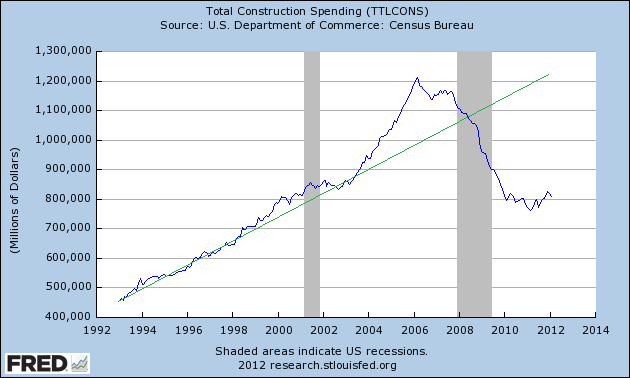Based on my recent conversations with general and concrete contractors, most contractors sense the “bottom” in the construction industry has occurred. However, most (if not all) contractors believe that an economic rebound to the 2006-2008 levels is not in the foreseeable future. According to the 4/19/2012 AIA Index, the commercial sector continues to lead the Architecture Billings Index which has remained in positive territory for the fifth consecutive month.
Based on data complied by the U.S. Department of Commerce, Total U.S. Construction Spending (TTLCONS) is currently at 2000 levels or at $800 Billion. (Note that is below the levels seen during the last official U.S. recession in 2001.) TTLCONS is correlated with the underlying cost of construction which includes the cost of material, labor, engineering, interest and taxes. It is more analogous to construction revenues than to construction activity.
The trend-line (in green) illustrates three obvious points:
- During 2005-2007, there was significant “over-building” due to various policy and credit reasons. At the peak, TTLCONS was 20% above the trend-line.
- During the 2008-2009 “Great Recession” (shaded area), the construction industry was in free-fall due to tightening credit and lack of demand. TTLCONS dropped from $1,100B to $900B – almost 20% in an 18-month period! Accordingly, TTLCONS fell well below the trend line.
- Whereas other sectors of the U.S. economy started to rebound, the construction industry continued to weaken after the official Great Recession ended. From the peak-to-trough, TTLCONS dropped from $1,200B to $800B (or 33%). Based on the trend-line, TTLCONS should be at peak level of $1,200B today.
Assuming the trend-line is the normal path of construction spending, one can focus on how far off the path we are or one can focus on getting back to the path. One good sign of a bottom is that the construction industry has stopped talking about the former and started focusing on the latter. This belief is reinforced because construction financing for developers has become slightly less restrictive.
Whereas TTLCONS is a few standard deviations off the trend line, this could indicate that it should rebound to close some of the gap. Our company’s anecdotal evidence is that condominium construction is dead and has been mostly replaced by apartment construction, at least for high-rise post-tensioned buildings in Chicago.
That said, the big question is how sustainable is the uptick in the construction industry? I hate to end with a question, but it is symbolic of the relative uncertainty within the construction industry.
– Neel Khosa, Vice President, AMSYSCO
____________________________________________











